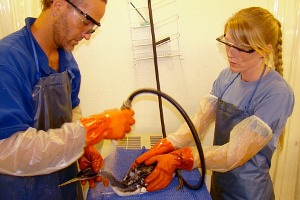 Staff at the International Bird Rescue and Research Center caring for oiled birds.
Staff at the International Bird Rescue and Research Center caring for oiled birds.
When two gigantic oil tankers collided near Golden Gate Bridge in 1971, more than 900,000 gallons of oil were spilled into the waters of the San Francisco Bay. Thousands of birds and animals were covered in oil and in great danger. Rescue centers to the scale that were needed did not exist. Concerned citizens and professionals snapped to attention and set up emergency centers, one being a facility in Richmond. Alice Berkner was one of those citizens and she was inspired by the efforts of the crew. As a registered nurse, she was also filled with ideas of how to improve on this brand new field. Alice and a group of volunteers were compelled to find the solution that worked best for future injured wildlife and The International Bird Rescue and Research Center (IBRRC) was born.
The center has since been working non-stop to save wildlife that suffers from oil spills and other disasters. In 2001, IBRRC helped to open the state-funded Oiled Wildlife Care and Education Center in Cordelia (Fairfield), California at the northern end of San Francisco Bay, a key facility in California's Oiled Wildlife Care Network. This facility contains IBRRC's new headquarters and the International Training Center for Oiled Wildlife Response. Their work includes training volunteers, consulting with the petrol industry, and managing a professional emergency response team. Their efforts have covered over 200 oil spills in 11 states, including the 1989 Exxon Valdez oil spill in Alaska. A southern rescue center in San Pedro, Los Angeles also contributes to the efforts.
What makes oil spills so toxic for birds?
Birds are made to be buoyant in the water, light in the air and warm and insulated wherever they go. Oil penetrates and opens up the structure of the plumage of birds, reducing its insulating ability, making the birds more vulnerable to temperature fluctuations. It also makes them heavy and less able to float above the water or take off for flight. In this exposed condition, they are unable to escape from predators or find food. As they attempt to preen themselves, they ingest the toxic substances. Unless there is human intervention, most birds affected by an oil spill do not survive.
